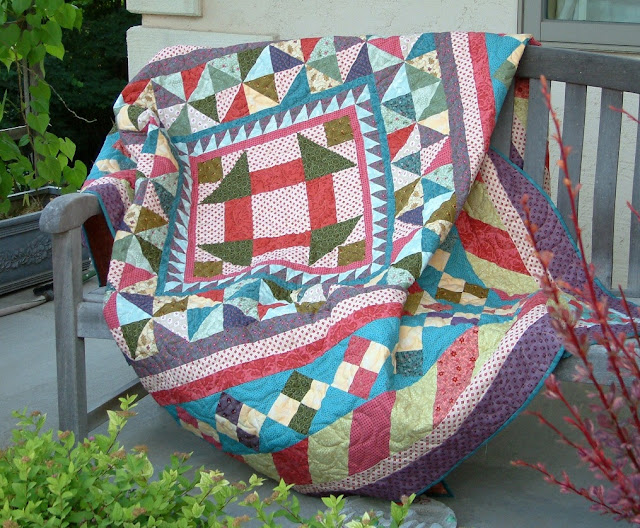I’ve written before about selling quilts, and the value vs. price problem. I choose not to sell my quilts (at this time,) because I reasonably believe that I value them far more than someone else would pay. In other words, the value to me is higher than the price I could charge. Consider a bed-sized quilt. If it takes 80 to 100 hours of my time, plus about $200 of direct material cost, plus overhead and marketing costs, plus profit, that quilt has a value (to me) of well over $2000. Will you pay me that much? If not, I’d rather give them away. (See end notes for links to my posts on this issue.)
Besides selling your quilts, another way to earn income in the quilting world is to create patterns. Thousands of quilters offer patterns, both for free and for payment. Some sell their designs through magazines or other publishers. Others market their patterns themselves.
If you are interested in writing patterns, I strongly encourage you to read a couple of posts on the subject. First, from Jennifer at See How We Sew, some advice on creating well-written patterns. Second, from Sam Hunter at Hunter’s Design Studio, a discussion on writing patterns, and what might have happened when a pattern isn’t well done.
One aspect Sam mentions is how well pattern-writing pays. Or not. If you want to make income from your patterns, this is a key piece of data.
Whether you write one pattern for pay, or write them full-time, it IS a business. Several months ago I had a frustrating experience when I decided to buy two patterns from a designer’s website. The process didn’t go well. Multiple attempts to contact her — by email and phone — went unanswered for many days. Her eventual emails to me blamed me, rather than taking responsibility for a glitch in her website. Finally she whined that sending out the problem pattern by mail (which I had not demanded) would cost her another $5. I told her that if that was all it cost her to learn a good lesson in customer service, it was a cheap lesson. She is talented at design but her business skills were lacking.
Another aspect of designing and pattern-writing to consider is copyright law on patterns. It can be very hard to protect your work, and the law isn’t clear on where the lines are drawn. If you’ve ever looked at a quilt and thought, “I don’t need to buy the pattern for that. I can draw that up myself,” you know what I mean. (If this concerns you, I’ll leave it to you to investigate for yourself. Copyright law is not my area of expertise.)
Now and then I’m asked to provide a pattern for one of my quilts. It’s a tremendous compliment and I take it seriously. But while I love to design, I’m not interested in writing patterns. The reasons are partly due to my personality, and partly because of my quilts.
First, to create a pattern and be sure that it provides good instructions, a pattern should be tested. Because I design as I go, I would need to make two quilts of the same design, with the second one as a test of instructions written only after the first was finished. I don’t want to make duplicate quilts. I want to make original quilts. So recreating a design, even for pattern testing, is not very interesting to me.
Second, in general, my quilts are complex. Writing accurate instructions would be time-consuming and difficult, and would suck all the fun out of quilt creation for me. Instructions you would get would be lengthy and difficult, and might well suck all the fun out of creation for you, too. Both of us would lose.
Third, and most important, I don’t want to help you make my quilts. I want to help you make your quilts. Your fabrics are different from mine, your vision is different from mine, you might have a specific purpose for your quilt. If you want to make your best friend a quilt loaded with friendship stars, by all means you should! If you have a wonderful piece of embroidery, or a great big print you’d like to use as a center block (Kate…), you should.
I can help you with that. But I can’t help you make your quilt your way AND tell you how to make my quilt my way. It’s a choice.
We are more powerful when we create from our own vision. For many people, it is harder to do that than to use someone else’s design and instructions. But I know from personal experience, and from feedback from my students, that original creation is incredibly rewarding. It feeds confidence and seeds more ideas for future work. Those seeds sprout and grow in unexpected ways. Here as elsewhere we reap what we sew.
If you’d like to read my posts on quilting as a business, you can find them here:
Quilting for Pay — The Longarm
Conversations with Artists
Price vs. Value of a Quilt, Part 1
Price vs. Value of a Quilt, Part 2
You Should Write Patterns
“It Feels Weird Asking for Pay”
Pay for Quilters (And other Crafters and Artists)
You Should Sell Those: A Play in Three Short Scenes, With Commentary
Cotton — Where Does Your Fabric Come From?
Cotton — What Happens After Harvest?
Cotton — Weaving Fabric
Cotton — Batik Production
Cotton — Printing Designs




